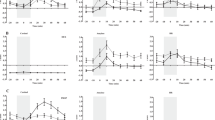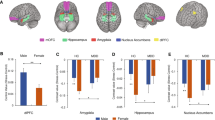Abstract
Many anxiety disorders, as well as major depressive disorder (MDD), are at least twice as prevalent in women as in men, but the neurobiological basis of this discrepancy has not been well studied. MDD is often precipitated by exposure to uncontrollable stress, and is frequently characterized by abnormal or disrupted prefrontal cortex (PFC) function. In animals, exposure to stress has been shown to cause PFC dysfunction, but sex differences in this effect have not been investigated. The present study tested male and female rats on a PFC-dependent working memory task after administration of FG7142, a benzodiazepine inverse agonist that activates stress systems in the brain. Female rats were impaired by lower doses than males during proestrus (high estrogen), but not during estrus (low estrogen). Similarly, ovariectomized females showed increased stress sensitivity only after estrogen replacement. These results suggest that estrogen amplifies the stress response in PFC, which may increase susceptibility to stress-related disorders.
This is a preview of subscription content, access via your institution
Access options
Subscribe to this journal
Receive 12 print issues and online access
$259.00 per year
only $21.58 per issue
Buy this article
- Purchase on Springer Link
- Instant access to full article PDF
Prices may be subject to local taxes which are calculated during checkout





Similar content being viewed by others
References
Weissman MM, Livingston Bruce M, Leaf PJ, Florio LP, Holzer CI . Affective disorders. In: Robins LE, Regier DA, (eds). Psychiatric Disorders in America: The Epidemiologic Catchment Area Study. The Free Press: New York, 1991, pp 53–80.
Breslau N, Chilcoat HD, Kessler RC, Peterson EL, Lucia VC . Vulnerability to assaultive violence: further specification of the sex difference in post-traumatic stress disorder. Psychol Med 1999; 29: 813–821.
Association AP (ed). Diagnostic and Statistical Manual of Mental Disorders, 4th edn. American Psychiatric Association: Washington, DC, 2000.
Zubenko GS, Hughes III HB, Maher BS, Stiffler JS, Zubenko WN, Marazita ML . Genetic linkage of region containing the CREB1 gene to depressive disorders in women from families with recurrent, early-onset, major depression. Am J Med Genet 2002; 114(8): 980–987.
Zubenko GS, Hughes HB, Stiffler JS, Brechbiel A, Zubenko WN, Maher BS et al. Sequence variations in CREB1 cosegregate with depressive disorders in women. Mol Psychiatry 2003; 8: 611–618.
Newton S, Thome J, Wallace TL, Shirayama Y, Schlesinger L, Sakai N et al. Inhibition of cAMP response element-binding protein or dynorphin in the nucleus accumbens produces an antidepressant-like effect. J Neurosci 2002; 24(22): 10883–10890.
Baxter LR, Schwartz JM, Phelps ME, Mazziotta JC, Guze BH, Selin CE et al. Reduction of prefrontal cortex glucose metabolism common to three types of depression. Arch Gen Psychiatry 1989; 46: 243–250.
Drevets WC, Price JL, Simpson JRJ, Todd RD, Reich T, Vannier M et al. Subgenual prefrontal cortex abnormalities in mood disorders. Nature 1997; 386: 824–827.
Elliott R, Baker SC, Rogers RD, O'Leary DA . Prefrontal dysfunction in depressed patients performing a complex planning task: a study using positron emission tomography. Psycholog Med 1997; 27: 931–942.
Mayberg HS, Liotti M, Brannan SK, McGinnis S, Mahurin RK, Jerabek PA et al. Reciprocal limbic-cortical function and negative mood: converging PET findings in depression and normal sadness. Am J Psychiatry 1999; 156: 675–682.
Goldman-Rakic PS . The prefrontal landscape: implications of functional architecture for understanding human mentation and the central executive. Phil Trans R Soc London 1996; 351: 1445–1453.
Robbins TW . Dissociating executive functions of the prefrontal cortex. Phil Trans R Soc London 1996; 351: 1463–1471.
Arnsten AFT . The biology of feeling frazzled. Science 1998; 280: 1711–1712.
Dorow R, Horowski R, Pashelke G, Amin M, Braestrup C . Severe anxiety induced by FG7142, a B-carboline ligand for benzodiazepine receptors. The Lancet 1983; 2(8341): 98–99.
Arnsten AFT . Through the looking glass: differential noradrenergic modulation of prefrontal cortical function. Neural Plast 2000; 7: 133–146.
Birnbaum SG, Podell DM, Arnsten AFT . Noradrenergic alpha-2 receptor agonists reverse working memory deficits induced by the anxiogenic drug, FG7142, in rats. Pharmacol Biochem Behav 2000; 67: 397–403.
Kritzer MF, Kohama SG . Ovarian hormones influence morphology, distribution and density of tyrosine hydroxylase immunoreactive axons in the dorsolateral prefrontal cortex of adult rhesus monkeys. J Comp Neurol 1998; 395: 1–17.
Becker J . Oestrogen effects on dopaminergic function in striatum. Novart Found Symp 2000; 230: 134–145.
Caticha OOW, Wilson DE, Dowdell LA, Noth RH, Swislocki AL, Lamothe JJ, Barrow R . Estradiol stimulates cortisol production by adrenal cells in estrogen-dependent primary adrenocortical nodular dysplasia. J Clin Endocrinolog Metabol 1993; 77(2): 494–497.
Grundemann D, Schechinger B, Rappold GA, Schomig E . Molecular identification of the cortisone-sensitive extraneuronal catecholamine transporter. Nature Neurosci 1998; 1: 349–351.
Garcia-Segura LM, Azcoitia I, DonCarlos LL . Neuroprotection by estradiol. Progr Neurobiol 2001; 63: 29–60.
Hernandez-Diaz FJ, Snachez JJ, Abreu P, Lopez-Coviella I, Tabares L, Prieto L et al. Estrogen modulates alpha-1/beta-adrenoceptor-induced signaling and melatonin production in female rat pinealocytes. Neuroendocrinology 2001; 73: 111–122.
Karkanias GB, Li CS, Etgen AM . Estradiol reduction of alpha-2-adrenoceptor binding in female rat cortex is correlated with decreases in alpha2A/D-adrenoceptor messenger RNA. Neuroscience 1997; 81: 593–597.
McGinnis MY, Krey LC, MacLusky NJ, McEwen BS . Steroid receptor levels in intact and ovariectomized estrogen-treated rats: An examination of quantitative, temporal and endocrine factors influencing the efficacy of an estriol stimulus. Neuroendocrinology 1981; 33: 158–165.
Larsen JK, Divac I . Selective ablations within the prefrontal cortex of the rat and performance of delayed alternation. Physiolog Psychol 1978; 6: 15–17.
Bilang-Bleuel ARJ, De carli S, Holsboer F, Reul JM . Forced swimming evokes a biphasic response in CREB phosphorylation in extrahypothalamic limbic and neocortical brain structures in the rat. Eur J Neurosci 2002; 15(6): 1048–1060.
Murphy BL, Arnsten AFT, Jentsch JD, Roth RH . Dopamine and spatial working memory in rats and monkeys: pharmacological reversal of stress-induced impairment. J Neurosci 1996; 16: 7768–7775.
Arnsten AFT, Goldman-Rakic PS . Noise stress impairs prefrontal cortical cognitive function in monkeys: evidence for a hyperdopaminergic mechanism. Arch Gen Psychiatry 1998; 55: 362–369.
Bowman RE, Ferguson D, Luine VN . Effects of chronic restraint stress and estradiol on open field activity, spatial memory, and monoaminergic neurotransmitters in ovariectomized rats. Neuroscience 2002; 113(2): 401–410.
Molina-Hernandez MT-AN . Antidepressant-like actions of pregnancy and progesterone in Wistar rats forced to swim. Psychoneuroendocrinology 2001; 26(5): 479–491.
Wood GE, Shors TJ . Stress facilitates classical conditioning in males, but impairs classical conditioning in females through activational effects of ovarian hormones. Proc Natl Acad Sci USA 1998; 95: 4066–4071.
Shors TJ, Lewczyk C, Pacynski M, Mathew PR, Pickett J . Stages of estrous mediate the stress-induced impairment of associative learning in the female rat. Neuroreport 1998; 9: 419–423.
Hayward C, Sanborn K . Puberty and the emergence of gender differences in psychopathology. J Adolescent Health 2002; 30(4, Suppl 1): 49–58.
Born L, Shea A, Steiner M . The roots of depression in adolescent girls: is menarche the key? Curr Psychiatry Rep 2002; 4(6): 449–460.
Bebbington P, Dunn G, Jenkins R, Lewis G, Brugha T, Farrell M et al. The influence of age and sex on the prevalence of depressive conditions: report from the National Survey of Psychiatric Morbidity. Psychol Med 1998; 28: 9–19.
Schmidt P, Berman K, Danaceau M, Keenan P, Nieman L, Rubinow D . Gonadal steroids, brain, and behavior. Biol Psychiatry 2000; 47: 5S.
Schmidt PJ, Nieman L, Danaceau MA, Tobin MB, Roca CA, Murphy JH et al. Estrogen replacement in perimenopause-related depression: a preliminary report. Am J Obstet Gynecol 2000; 183: 414–420.
Acknowledgements
We thank Tracy Sadlon, Lisa Ciavarella, Sam Johnson, and Tony Griffith for their technical help with this project. This research was supported by a grant from the Ethel F Donoghue Women's Health Investigator Program at Yale to AFTA.
Author information
Authors and Affiliations
Corresponding author
Rights and permissions
About this article
Cite this article
Shansky, R., Glavis-Bloom, C., Lerman, D. et al. Estrogen mediates sex differences in stress-induced prefrontal cortex dysfunction. Mol Psychiatry 9, 531–538 (2004). https://doi.org/10.1038/sj.mp.4001435
Received:
Revised:
Accepted:
Published:
Issue Date:
DOI: https://doi.org/10.1038/sj.mp.4001435



